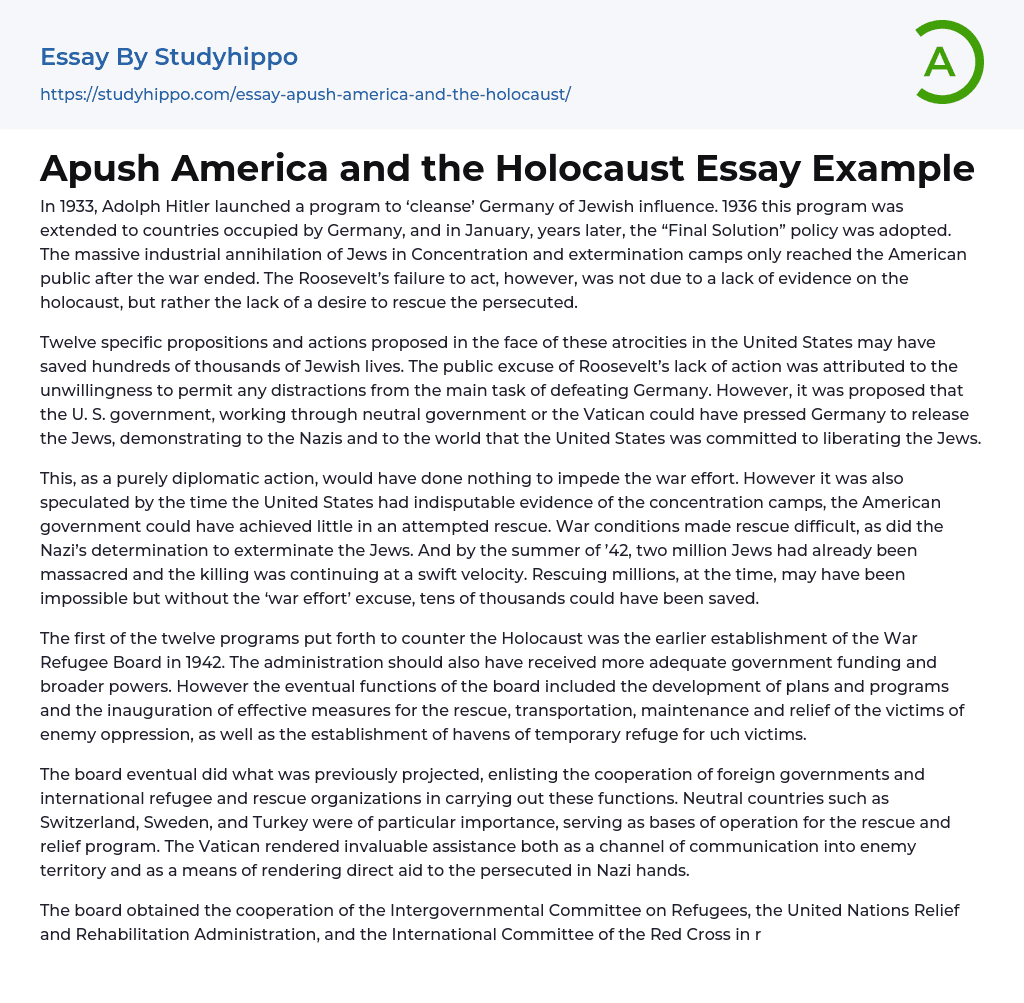In 1933, Adolph Hitler launched a program to ‘cleanse’ Germany of Jewish influence. 1936 this program was extended to countries occupied by Germany, and in January, years later, the “Final Solution” policy was adopted. The massive industrial annihilation of Jews in Concentration and extermination camps only reached the American public after the war ended. The Roosevelt’s failure to act, however, was not due to a lack of evidence on the holocaust, but rather the lack of a desire to rescue the persecuted.
Twelve specific propositions and actions proposed in the face of these atrocities in the United States may have saved hundreds of thousands of Jewish lives. The public excuse of Roosevelt’s lack of action was attributed to the unwillingness to permit any distractions from the main task of defeating Germany. However, it was proposed that the U. S.
...government, working through neutral government or the Vatican could have pressed Germany to release the Jews, demonstrating to the Nazis and to the world that the United States was committed to liberating the Jews.
This, as a purely diplomatic action, would have done nothing to impede the war effort. However it was also speculated by the time the United States had indisputable evidence of the concentration camps, the American government could have achieved little in an attempted rescue. War conditions made rescue difficult, as did the Nazi’s determination to exterminate the Jews. And by the summer of ’42, two million Jews had already been massacred and the killing was continuing at a swift velocity. Rescuing millions, at the time, may have been impossible but without the ‘war effort’ excuse, tens of thousands could have been saved.
The first o
the twelve programs put forth to counter the Holocaust was the earlier establishment of the War Refugee Board in 1942. The administration should also have received more adequate government funding and broader powers. However the eventual functions of the board included the development of plans and programs and the inauguration of effective measures for the rescue, transportation, maintenance and relief of the victims of enemy oppression, as well as the establishment of havens of temporary refuge for uch victims.
The board eventual did what was previously projected, enlisting the cooperation of foreign governments and international refugee and rescue organizations in carrying out these functions. Neutral countries such as Switzerland, Sweden, and Turkey were of particular importance, serving as bases of operation for the rescue and relief program. The Vatican rendered invaluable assistance both as a channel of communication into enemy territory and as a means of rendering direct aid to the persecuted in Nazi hands.
The board obtained the cooperation of the Intergovernmental Committee on Refugees, the United Nations Relief and Rehabilitation Administration, and the International Committee of the Red Cross in recuperating and resettling refugees, finding temporary shelters for rescued victims, transporting these victims to the shelters and providing for their maintenance in transit, and making relief deliveries inside enemy territory.
Much larger sums of money should have been transferred to Europe through the WRB, the tiny trickle was only increased after the Board was concrete. However, many of this aid came too late to rescuing millions of persecuted Jews. Arguments have insisted the stronger pressure had been needed to be applied to neutral countries near the Axis, such as Spain, Portugal, Switzerland and Sweden in order
to house the fleeing Jews. Locating outside havens were also needed, in places beyond continental Europe were refuges could safely away postwar resentment.
Shipping was needed as well to transfer Jews from neutral territory to said havens. In 1943 Assistant Secretary of State Brekin was reasoned that why the States department was issuing so little visas to refugees was the lack of ample shipping, however, this was incorrect. Throughout the war three Portuguese liners, neutral vessels sailed regularly between Lisbon and U. S. Each ship made the journey every six weeks; however because of the Americans tight visa policy they carried only a slice of their potential load.
Military action could also have been instituted with little impediment on the war effort. The Air force could have eliminated the Auschwitz killing installments and the bombing of deportation railroads was possible. Allied radio could have spread the information at all wavelengths for weeks at a time, increasing the publicity and public outcry of the factories. A campaign to stimulate and assist escapes would have increased the outflow of Jews.
Once neutral nations agreed to open their borders information on the assistance could have been spread by radio, airdropped leaflets and underground communication channels. There were many workable plans that could have aided distressed Jews during the Holocaust. Transportation and communication were widely available to aid and inform the populist of the Nazis’ genocide; however the United States governments hid behind feeble excuses. The only obstacle keeping aid from European Jews was a lack of desire to initiate rescue.
- Anne Frank essays
- Fascism essays
- D-day essays
- Antisemitism essays
- Black History Month essays
- Black Lives Matter essays
- I Have a Dream essays
- Ku Klux Klan essays
- Malcolm X essays
- Martin Luther King essays
- Miscegenation essays
- Racial Inequality essays
- Racial Segregation essays
- Adolf Hitler essays
- Concentration Camps essays
- Elie Wiesel essays
- Holocaust essays
- Nazi Party essays
- Weimar Republic essays
- American Civil War essays
- Atomic Bomb essays
- Attack essays
- Cold War essays
- Crimean War essays
- Diplomacy essays
- Emilio Aguinaldo essays
- Emperor essays
- Hitler essays
- Iraq War essays
- Korean War essays
- Mexican American War essays
- Nazism essays
- Nuclear Weapon essays
- Philippine Revolution essays
- Revolutionary War essays
- Rwanda essays
- The Spanish American War essays
- Trench Warfare essays
- Tribe essays
- Vietnam War essays
- War of 1812 essays
- Western Front essays
- World War I essays
- World War Ii essays




